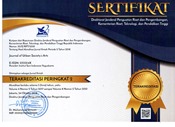Characteristics of Cultural Production of Youtube Podcast of Horror Genre in Relevance with the Construction of the Consumer Society
Abstract
The emergence of the horror genre YouTube Podcast during the Covid-19 pandemic is related to restrictions on people’s movement, both in the production process and in enjoying the results of the production. For this reason, characteristics of cultural production emerged during the pandemic through horror podcasts on YouTube which also influenced the construction of consumer society. This is important to study in the world of the arts industry because these two orders, the production order and the consumption order, correlate with each other to shape the meaning of society. Baudrillard argued that consumption of commodities is not only seen at the level of their function, but also the relationship of meaning between the commodity and the sign it produces. Consumption looks more at the context of the existence of society itself so that it is said to be a growth society because it has the ability to produce both prosperity and poverty. The netnographic method is used to examine the relationship between the two orders so as to form meaning as a social phenomenon. The characteristics of horror genre podcasts are that they are produced with simple production, a limited number of personnel, delivered orally with distinctive characteristics, and have a production strategy that causes the audience to always wait for the next production result. The concept of horror which is used as a genre choice in podcasts is rooted in the local wisdom of podcast fans so that even though the label of modern society is attached to the activity of enjoying horror podcasts, the roots of local wisdom always color and bind the memories of the viewers to return to their identity through local wisdom.
Kemunculan Podcast YouTube bergenre horror pada masa pandemi Covid-19 terkait dengan pembatasan ruang gerak masyarakat, baik proses produksi maupun penikmatan hasil produksi. Untuk itu, muncul karakteristik produksi kultural pada masa pandemi melalui podcast horror di YouTube yang juga mempengaruhi konstruksi masyarakat konsumennya. Hal ini penting untuk dikaji dalam dunia industri seni karena kedua tatanan tersebut, tatanan produksi dan tatanan konsumsi, saling berkorelasi membentuk permaknaan atas masyarakatnya. Baudrillard mengemukakan bahwa konsumsi atas komoditas tidak sekadar dilihat pada tataran fungsinya, tetapi relasi makna antara komoditas dan tanda yang dimunculkannya. Pengonsumsian lebih melihat pada konteks eksistensi masyarakat itu sendiri sehingga dikatakan sebagai masyarakat pertumbuhan karena memiliki kemampuan untuk memproduksi kemakmuran sekaligus kemiskinan. Digunakan metode netnografi untuk menelaah relasi kedua tatanan itu sehingga membentuk permaknaan sebagai suatu fenomena sosial. Karakteristik podcast bergenre horror diproduksi dengan produksi sederhana, jumlah personil terbatas, disampaikan secara lisan dengan karakteristik yang khas, memiliki strategi produksi yang menyebabkan penikmatnya senantiasa menanti hasil produksi berikutnya. Konsep horror yang dijadikan pilihan genre dalam podcast mengakar pada local kearifan dari penikmat podcast sehingga sekalipun label masyarakat modern melekat dalam aktivitas menikmati podcast horror, tetapi akar kearifan lokal senantiasa mewarnai dan mengikat ingatan para penikmat untuk kembali pada jati diri melalui kearifan lokal tersebut.
Keywords
Full Text:
PDFReferences
Baudrillard, J. (1998) The Consumer Society: Myths and Structures. London-Thousand Oaks-New Delhi: SAGE Publications.
Berawi, MA (2018) ‘The Fourth Industrial Revolution: Managing Technology Development for Competitiveness’, International Journal of Technology, 9(1), p. 1. Available at: https://doi. org/10.14716/ijtech.v9i1.1504.
Berawi, MA (2021) ‘Innovative Technology for Post-Pandemic Economic Recovery’, International Journal of Technology, 12(1), p. 1. Available at: https://doi.org/10.14716/ijtech.v12i1.4691.
Bertoncelj, A. (2022) ‘Digital Transformation in the Context of the European Union’s Green Deal’, www.amfiteatrueconomic.ro, 24(59), p. 5. Available at: https://doi.org/10.24818/EA/2022/59/5.
Buhaichuk, O., Nikitenko, V. and Voronkova, V. (2023) ‘Formation of A Digital Education Model in Terms of The Digital Economy (Based on The Example of EU Countries)’, Baltic Journal of Economic Studies, 9(1 ), pp. 53–60. Available at: https://doi.org/10.30525/2256-0742/2023-9-1-53-60.
Camargo, R. (2020) ‘Drawing in Personal Training and as a Cultural Practice of Knowledge Circulation’, Formazione & Insegnamento, 18(2), pp. 22–35. Available at: https://doi.org/https://doi.org/10. 7346/-fei-XVIII-02-20_03.
van Eldik, AK et al. (2019) ‘Urban Influencers: An Analysis of Urban Identity in YouTube Content of Local Social Media Influencers in a Super-Diverse City’, Frontiers in Psychology, 10. Available at: https://doi.org/10.3389/fpsyg.2019.02876 .
Haggis, M. (2016) ‘Creator’s Discussion of The Growing Focus on, and Potential of, Storytelling in Video Game Design’, Persona Studies, 2(1), pp. 20–25. Available at: https://doi.org/10.21153/ ps2016vol2no1art532.
Lázaro, A. (2017) ‘The Dark Side of British Horror Fiction: Politics, Taboos and Censorship’, ELOPE: English Language Overseas Perspectives and Inquiries, 14(2), pp. 69–81. Available at: https://doi. org/10.4312/elope.14.2.69-81.
Liu, Y. et al. (2019) ‘A Data-Centric Internet of Things Framework Based on Azure Cloud’, IEEE Access, 7, pp. 53839–53858. Available at: https://doi.org/10.1109/ACCESS.2019.2913224.
Poernomo, CA, Wibowo, JH and Jupriono (2023) ‘Analysis of the Creative Content Production Process on the Kembara Sunyi Youtube Channel’, in Proceedings of Semakom (National Communication Student Seminar): Communication, Collaboration, & Literacy. Surabaya: University 17 August 1945 Surabaya, pp. 161–167. Available at: https://conference.untag-sby.ac.id/index.php/bisnisom/ article/view/1929.
Pramayoza, D. and Birowo, P. (2022) ‘The Transition of Dramaturgy During Pandemic: From Staging to Streaming’, Journal of Urban Society’s Arts, 9(1), pp. 71–86. Available at: https://doi.org/10.24821/ jousa.v9i1.6697.
Qura, U. et al. (2022) ‘The Effect of YouTube Podcasts on Improving Speaking Skills’, Ranah: Journal of Language Studies, 11(2), p. 351. Available at: https://doi.org/10.26499/rnh.v11i2.5147.
Ribeiro, RGT et al. (2019) ‘Pedagogical Usage of Digital Technologies in an Indigenous Village in Brazil: Reflections and Challenges’, Interaction Design and Architecture(s), (41), pp. 50–61. Available at: https://doi.org/10.55612/s-5002-041-004.
Sofino, S. and Pradikto, B. (2022) ‘Implementation of Blended Learning Using YouTube Podcast Media by Involving Bureaucrats and Non-formal Education Practitioners in Improving Student Learning Outcomes in Non-formal Education Study Programs’, Aksara: Journal of Non-formal Education Science, 8(1), p. 503. Available at: https://doi.org/10.37905/aksara.8.1.503-512.2022.
Winardi, K. and Handayani, LLA (2019) ‘Dream Interpretation of an Infant and Feminine Monstrosity in Among the Sleep’, Journal of Urban Society’s Arts, 6(1), pp. 1–11. Available at: https://doi. org/10.24821/jousa.v6i1.2780.
DOI: https://doi.org/10.24821/jousa.v11i2.11083
Refbacks
- There are currently no refbacks.

This work is licensed under a Creative Commons Attribution 4.0 International License. ISSN 2355-2131 (print) | ISSN 2355-214X (online).






